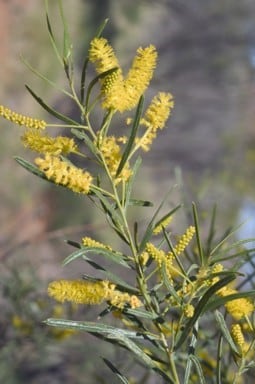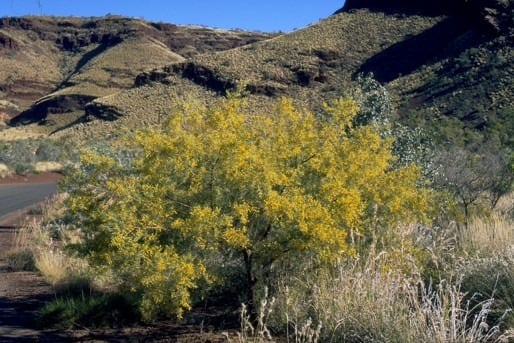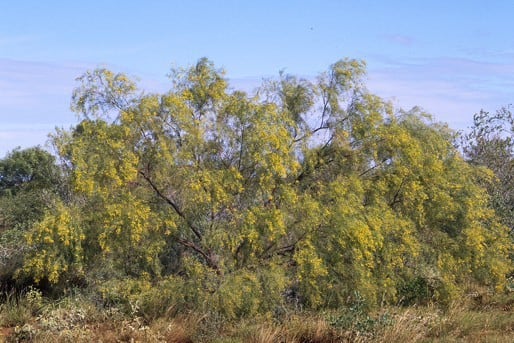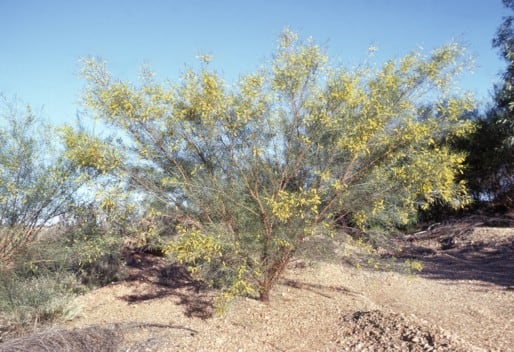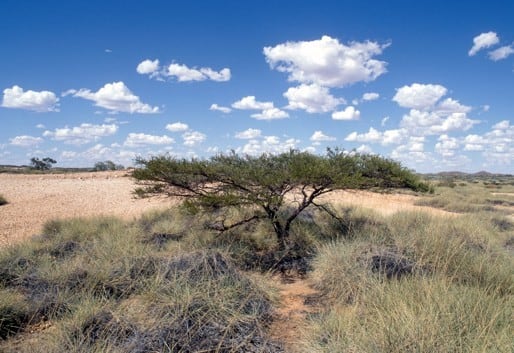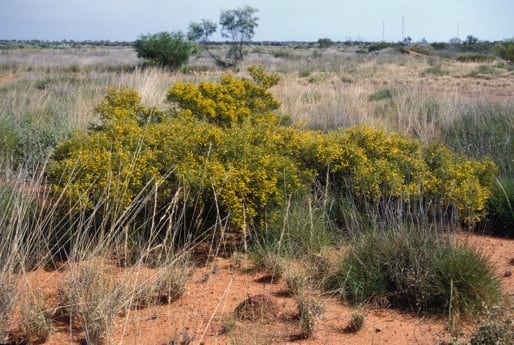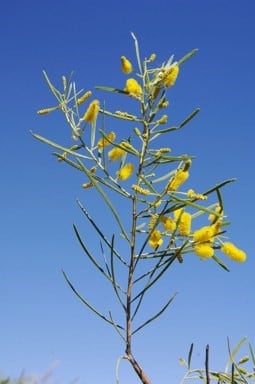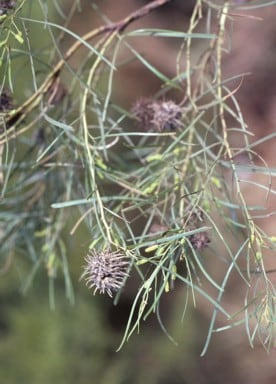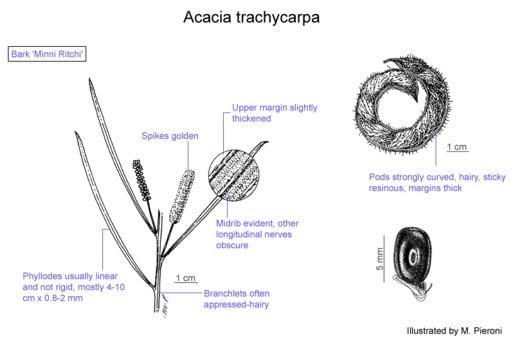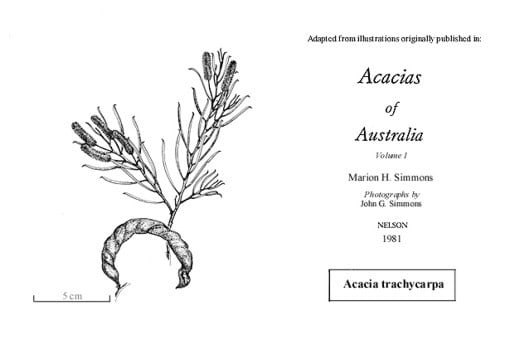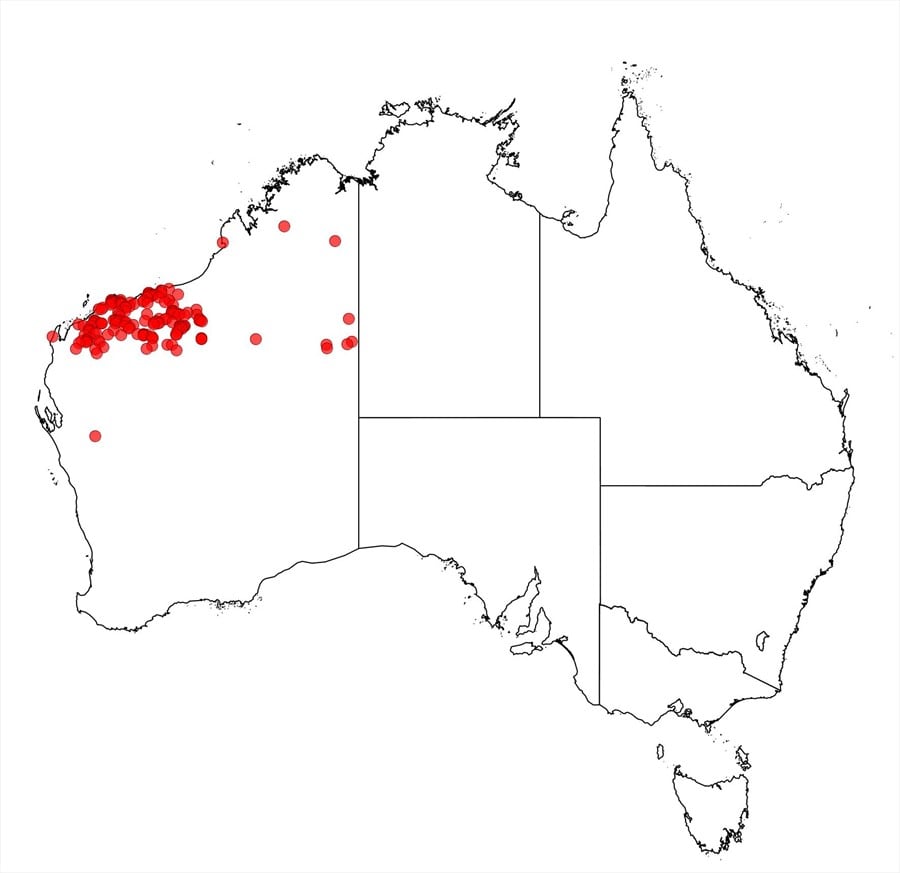Acacia trachycarpa E.Pritz.
WATTLE
Acacias of Australia
Common Name
Pilbara Minni Ritchi
Family
Fabaceae
Distribution
Mostly confined to the Pilbara region of NW W.A. where it is widespread and common, usually along creeks and rivers, mostly to the N and W of the Hamersley Ra.; an outlier occurs in the Kimberley region.
Description
Resinous shrub or small tree 1–5 m high, with spreading and sometimes flat-topped crowns, ultimate branchlets sometimes ±pendulous. Bark ‘Minni Ritchi’, burgundy red to red-brown. Branchlets sparsely appressed-hairy, sometimes glabrous. New shoots slightly viscid, light green. Stipules persistent, 0.5–1 mm long. Phyllodes usually linear, (1.5–) 4–10 (–15) cm long, 0.8–2 (–5) mm wide, innocuous or ±pungent-pointed, usually soft, delicate and not rigid, subglabrous or more commonly with often sparse appressed ±silky hairs on nerves and margins; multinerved but normally only the central nerve evident, the upper margin slightly thickened and broader than lower margin; gland 1, basal, to 7 mm above pulvinus. Peduncles 5–15 mm long; spikes mostly mostly 10–20 x 3–5 mm (when dry), golden. Bracteoles less than 1 mm long. Bracteoles less than 1 mm long. Flowers 5-merous; calyx gamosepalous, dissected to 1/5–2/3 or more, golden-hairy; petals 1.2–1.7 mm long, 1-nerved. Pods mostly straight-sided to scarcely constricted between seeds, curved to circinnate (but often irregularly so), ±flat, 3–11 cm long, 7–12 mm wide, coriaceous, resinous and viscid, finely reticulately nerved, golden sericeous when young, later ±glabrescent. Seeds ±oblique, round to oblong, flattened, 5–8 x 4–7 mm, depressed at centre, brown to black, pitted; pleurogram with yellowish grey halo; areole round or oblong, closed, greyish brown.
Phenology
Flowers April.–Aug., sometimes Oct.
Habitat
Grows mainly in sandy clay loam derived from alluvium, in a variety of habitats (see notes).
Specimens
W.A.: 42 miles [67.2 km] E of Dampier, F.Lullfitz 6156 (CANB, K, MEL, NSW); Port Hedland, I.V.Newman 674 (NSW); Fortescue R., Millstream, M.I.H.Brooker 2056 (MEL, NSW, PERTH); Nullagine, F.Lullfitz 6185 (CANB, K, NSW).
Notes
Acacia trachycarpa has affinities with A. chisholmii, A. cyclocarpa, A. effusa, A. gracillima, A. minniritchi and A. lysiphloia. It hybridizes with A. tumida (see A. trachycarpa × tumida var. pilbarensis) and rarely with A. eriopoda (see A. eriopoda × trachycarpa) and A. monticola (see A. monticola × trachycarpa); see also A. sp. Nullagine (B.R. Maslin 4955) and A. sp. Marble Bar (J.G. and M.H.Simmons 3499). A rare possible hybrid between A. trachycarpa and A. stellaticeps is recorded from near Roebourne but as the plant has not been relocated this entity remains ambiguous. Plants described by B.R.Maslin, Nuytsia 4: 405–407 (1983) as A. ancistrocarpa × trachycarpa and subsequently included in Fl. Australia 11B: 246 (2001) are now referable to A. trachycarpa × tumida var. pilbarensis.
Acacia trachycarpa is a polymorphic species. Typical A. trachycarpa is a spreading, obconic tree or shrub about 2–5 m high with phyllodes mostly 4–10 cm long, 1–2 mm wide and not rigid; these plants are normally found along rivers and creeks. An apparent ecotype of A. trachycarpa occurs sporadically throughout much of the species’ geographic range in areas away from water courses. It has phyllodes (1.5–) 2–4 cm long, occasionally 3–5 mm wide, and generally more erect and sometimes more rigid than those of the typical variant; it grows as a spreading shrub up to 1 m high. It has been recorded from a range of sites which include: coastal dunes (Finucane Is., Anon. 273, PERTH), gravelly, spinifex plains (5.1 km E of Nullagine, L.Thomson 1149, PERTH), road verges (11.5 km E of Wittenoom on road to Port Hedland, B.R.Maslin 4645, PERTH) and rocky ranges (Barlee Range Nature Reserve, 19.2 km SE Mt Florrie, S.van Leeuwen 1583, PERTH).
A reasonably fast-growing species that is reported to be frost sensitive and not very drought tolerant. Plants are killed by intense fires but have the ability to resprout after cool fires or mechanical clearing. It is used in amenity plantings in places in the Pilbara (e.g. Karratha) and has also been introduced into West Africa for firewood and stock fodder. Further details on its utilisation are given in J.C.Doran & J.W.Turnbull (eds), Australian Trees & Shrubs: Species for Land Rehabilitation & Farm Planting in the Tropics 134–135 (1997). Indigenous people in the west and central Pilbara used this species for a variety of purposes, see B.R.Maslin et al., Wattles of the Pilbara CD-ROM (2010).
An undescribed variant of A. trachycarpa occurs in the Great Sandy Desert–Lake Mackay region of central Australia, see Acacia sp. Lake Mackay (P.K.Latz 12836).
FOA Reference
Data derived from Flora of Australia Volumes 11A (2001), 11B (2001) and 12 (1998), products of ABRS, ©Commonwealth of Australia
Author
Revised by B.R.Maslin
Dr M.D.Tindale and Dr P.G.Kodela with the assistance of M.Bedward, S.J.Davies, C.Herscovitch, D.A.Keith and/or D.A.Morrison, M.W.Mcdonald
This identification key and fact sheets are available as a mobile application:
URL: https://apps.lucidcentral.org/wattle/
© Copyright 2018. All rights reserved.
